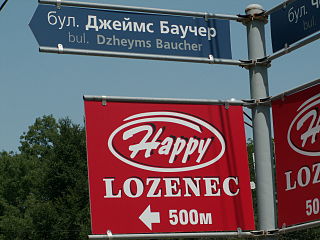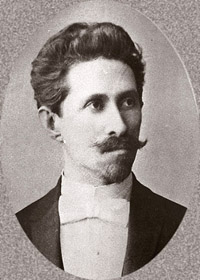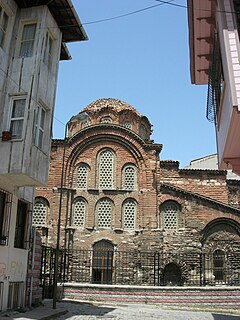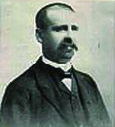Coordinates: 42°41′23″N23°19′40″E / 42.68972°N 23.32778°E

A geographic coordinate system is a coordinate system that enables every location on Earth to be specified by a set of numbers, letters or symbols. The coordinates are often chosen such that one of the numbers represents a vertical position and two or three of the numbers represent a horizontal position; alternatively, a geographic position may be expressed in a combined three-dimensional Cartesian vector. A common choice of coordinates is latitude, longitude and elevation. To specify a location on a plane requires a map projection.
Contents


The Sveti Sedmochislenitsi Church (Bulgarian : църква „Свети Седмочисленици“) is a Bulgarian Orthodox church in Sofia, the capital of Bulgaria. It was created between 1901 and 1902 through the conversion of an abandoned Ottoman mosque, and was inaugurated on 27 July 1903. The church is named after Cyril and Methodius and their five disciples, known in the Orthodox Church collectively as the Sedmochislenitsi.

Bulgarian, is an Indo-European language and a member of the Southern branch of the Slavic language family.

Sofia is the capital and largest city of Bulgaria. The city is at the foot of Vitosha Mountain in the western part of the country. Being in the centre of the Balkan peninsula, it is midway between the Black Sea and the Adriatic Sea, and closest to the Aegean Sea.

The Ottoman Empire, also historically known in Western Europe as the Turkish Empire or simply Turkey, was a state that controlled much of Southeast Europe, Western Asia and North Africa between the 14th and early 20th centuries. It was founded at the end of the 13th century in northwestern Anatolia in the town of Söğüt by the Oghuz Turkish tribal leader Osman I. After 1354, the Ottomans crossed into Europe, and with the conquest of the Balkans, the Ottoman beylik was transformed into a transcontinental empire. The Ottomans ended the Byzantine Empire with the 1453 conquest of Constantinople by Mehmed the Conqueror.
The so-called Black Mosque (Bulgarian : Черна джамия, translit. Cherna dzhamiya; Turkish : Kara Camii) was built in 1528 on the order of Suleiman the Magnificent with the intention to be more impressive and beautiful than the Christian churches in the city. The mosque is popularly attributed to the famous Ottoman architect Mimar Sinan, although this is uncertain. It was constructed at the place of a former nunnery of the Rila Monastery and an Early Christian temple from the 4th-5th century, the ruins of which were excavated in 1901. An even older construction, a pagan temple of Asclepius from Roman Serdica, was also discovered in the mosque's foundations.

Romanization of Bulgarian is the practice of transliteration of text in Bulgarian from its conventional Cyrillic orthography into the Latin alphabet. Romanization can be used for various purposes, such as rendering of proper names and place names in foreign-language contexts, or for informal writing of Bulgarian in environments where Cyrillic is not easily available. Official use of romanization by Bulgarian authorities is found, for instance, in identity documents and in road signage. Several different standards of transliteration exist, one of which was chosen and made mandatory for common use by the Bulgarian authorities in a law of 2009.

Turkish, also referred to as Istanbul Turkish, is the most widely spoken of the Turkic languages, with around ten to fifteen million native speakers in Southeast Europe and sixty to sixty-five million native speakers in Western Asia. Outside Turkey, significant smaller groups of speakers exist in Germany, Bulgaria, North Macedonia, Northern Cyprus, Greece, the Caucasus, and other parts of Europe and Central Asia. Cyprus has requested that the European Union add Turkish as an official language, even though Turkey is not a member state.

Suleiman I, commonly known as Suleiman the Magnificent in the West and Kanunî Sultan Süleyman in his realm, was the tenth and longest-reigning Sultan of the Ottoman Empire from 1520 until his death in 1566. Under his administration, the Ottoman state ruled over 15 to 25 million people.
The 25 m-long mosque had a square shape and a large lead-covered dome. The mosque was initially known as the Koca Mehmed Pasha Mosque after Mehmed-paša Sokolović. Another name was the İmaret Mosque after the imaret, a kitchen for the poor located in the vicinity, the ruins of which were found in 1912. A madrasah, a Muslim religious school, was located in what is now the small garden between the modern church and the Count Ignatiev School. The madrasah was later used as a prison after the Liberation of Bulgaria. Other Ottoman constructions nearby included a caravanserai and a hammam.

In Bulgarian historiography, the liberation of Bulgaria refers to those events of the Russo-Turkish War (1877–1878) that led to the re-establishment of the Bulgarian state under the Treaty of San Stefano of 3 March 1878.

A caravanserai was a roadside inn where travelers (caravaners) could rest and recover from the day's journey. Caravanserais supported the flow of commerce, information and people across the network of trade routes covering Asia, North Africa and Southeast Europe, most notably the Silk Road.

A Turkish bath is a place of public bathing associated with the culture of the Ottoman Empire and more widely the Islamic world. A variation on it as a method of cleansing and relaxation became popular during the Victorian era, and then spread through the British Empire and Western Europe. The buildings are similar to the thermae. Unlike Russian saunas (banya), which use ambient steam, Turkish baths focus on water.
The mosque received its more popular name, the Black Mosque, after the dark granite from which its minaret was made. The minaret collapsed during an earthquake in the 19th century and the mosque was abandoned by the Ottomans after the Liberation of Bulgaria in 1878 to become used as a military warehouse and prison.

Minaret, from Arabic: منارة manarah, also known as Goldaste, is a type of tower typically found built into or adjacent to mosques. Minarets serve multiple purposes. While they provide a visual focal point, they are generally used for the Muslim call to prayer (Adhan). The basic form of a minaret includes a base, shaft, a cap and head. They are generally a tall spire with a conical or onion-shaped crown. They can either be free-standing or taller than the associated support structure. The architecture, function, and role of the minaret vary by region and time period.
The architect who suggested the conversion of the once Ottoman mosque into a Christian church was the Russian Alexander Pomerantsev, responsible for the Upper Trade Rows on Red Square, among other buildings. The Bulgarian architects Yordan Milanov and Petko Momchilov designed the dome, the narthex and the bell tower in a traditional Bulgarian style, inspired by the movement of Romanticism. Only the central hall and the dome of the former mosque were preserved, with four oval bays, a narthex and an altar section being added.

Russia, officially the Russian Federation, is a transcontinental country in Eastern Europe and North Asia. At 17,125,200 square kilometres (6,612,100 sq mi), Russia is the largest country in the world by area, covering more than one-eighth of the Earth's inhabited land area, and the ninth most populous, with about 146.77 million people as of 2019, excluding Crimea. About 77% of the population live in the western, European part of the country. Russia's capital, Moscow, is the largest metropolitan area in Europe proper and one of the largest cities in the world; other major cities include Saint Petersburg, Novosibirsk, Yekaterinburg and Nizhny Novgorod. Extending across the entirety of Northern Asia and much of Eastern Europe, Russia spans eleven time zones and incorporates a wide range of environments and landforms. From northwest to southeast, Russia shares land borders with Norway, Finland, Estonia, Latvia, Lithuania and Poland, Belarus, Ukraine, Georgia, Azerbaijan, Kazakhstan, China, Mongolia and North Korea. It shares maritime borders with Japan by the Sea of Okhotsk and the U.S. state of Alaska across the Bering Strait. However, Russia recognises two more countries that border it, Abkhazia and South Ossetia, both of which are internationally recognized as parts of Georgia.

Alexander Nikanorovich Pomerantsev was a Russian architect and educator responsible for some of the most ambitious architectural projects realized in Imperial Russia and Bulgaria at the turn of the 20th century. An accomplished eclecticist, Pomerantsev practiced Art Nouveau, Byzantine, Russian Revival styles and collaborated with leading structural engineers of his period in creating new types of commercial buildings.

Red Square is a city square in Moscow, Russia. It separates the Kremlin, the former royal citadel and now the official residence of the President of Russia, from a historic merchant quarter known as Kitai-gorod. Red Square is often considered to be the central square of Moscow since the city's major streets, which connect to Russia's major highways, originate in the square.
The construction works took a year, between 27 May 1901 and 6 May 1902, but the complete inner decoration did not finish until 1996. Young artists painted the icons and among the first donors were Tsar Ferdinand (recognized as the primary church donor in 1905) and Ivan Evstratiev Geshov. Famous Bulgarian statesman Petko Karavelov also contributed significantly to the church's construction and was buried nearby in January 1903.

The large candlesticks in front of the altar were cast in 1903 from obsolete police badges from Eastern Rumelia and the Principality of Bulgaria (i.e. before the Unification in 1885). An electric clock, still in use, was created by the noted watchmaker Georgi Hadzhinikolov and fit to the western façade in the 1930s. The small garden and the square close to the church were also built in the period.
In the grounds of the Sveti Sedmochislenitsi is buried alongside his wife Petko Stoichev Karavelov (Bulgarian: Петко Каравелов) (24 March 1843 – 24 January 1903) a leading Bulgarian liberal politician, who served as Prime Minister on four occasions.

















